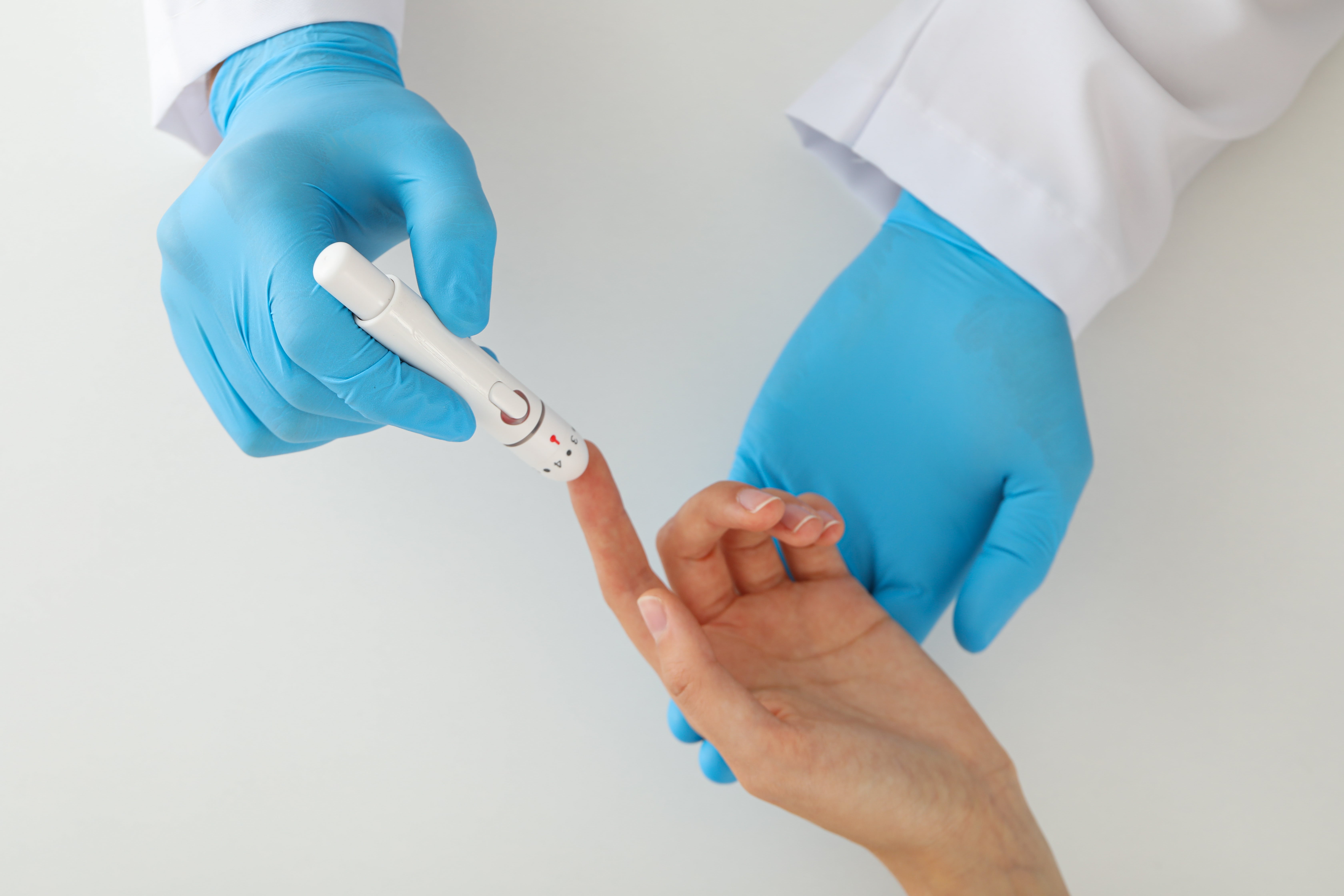Key Takeaways
- Diabetes prevention is not just about avoiding added sugar. Carbohydrates, meal timing, and how your body responds to insulin all play a bigger role in managing blood sugar.
- Many people with normal body weight still experience insulin resistance.
- Total daily physical activity, sleep quality, strength training, and stress management are all important pieces of the insulin sensitivity puzzle.
- Your glucose numbers matter, but so does how much they fluctuate.
- Lasting change takes time.
that {{mid-cta}}
Sometimes diabetes advice seems over-simplified. You’ve probably heard the same soundbites before: “Cut carbs. Lose weight. Exercise more.” While those tips might have some merit, they don’t capture the nuance of what it takes to improve your blood sugar and metabolic health.
Especially during National Diabetes Month, public health messages may leave you feeling confused, overwhelmed, or like you’re doing something wrong. The reality is that blood sugar and insulin regulation are influenced by a complex mix of hormones, lifestyle habits, and genetics. Let’s bust five common myths about metabolic health that we hear from people just like you, so you can better understand what it actually takes to improve your health.
Myth 1: Diabetes Is Only About Sugar Intake

Because diabetes is so closely tied to high blood sugar levels, it’s an easy jump to assume that the sugar we eat causes diabetes. And while overconsumption of sugar can certainly contribute to risk factors, it’s far from the full picture.
Carbohydrates of all kinds, not just added sugars, affect blood glucose levels, and how your body processes those carbs depends largely on your insulin response. When you eat, your body breaks carbohydrates into glucose, which enters your bloodstream. Insulin, a hormone made by the pancreas, acts like a “key,” opening the door for glucose to move into your cells for energy.
Plus, over time, factors like chronic stress, lack of sleep, physical inactivity, or carrying extra visceral fat can make your cells less responsive to insulin, a condition called insulin resistance. That’s where problems arise, sometimes months or years before a diabetes diagnosis is given.
Meal timing also plays a surprisingly big role. Research shows that eating balanced meals at consistent times, rather than skipping meals or loading up late at night, helps keep insulin and blood sugar in sync throughout the day.1 It’s less about cutting out every sweet treat and more about creating steady eating routines that support your metabolism and hormone balance long term.
Myth 2: Only Overweight People Get Type 2 Diabetes
It’s a common belief that only people who are overweight develop type 2 diabetes, but that’s simply not true. While excess weight, especially around the abdomen, is one risk factor, it’s just a piece of a much larger puzzle. Genetics, hormones, chronic stress, sleep patterns, and even environmental factors all influence your risk of developing insulin resistance and diabetes.
In fact, research shows that many people with a “normal” body weight still have insulin resistance. One reason this happens is that their fat distribution is less visible on the outside. Meaning they may carry visceral fat around the organs, which can quietly increase metabolic risk without showing up on the scale.2
What’s more, weight doesn’t always predict health outcomes.3 Some individuals in larger bodies have excellent insulin sensitivity and no metabolic issues, while others in smaller bodies may struggle with blood sugar regulation. That’s why focusing solely on body weight can lead to missed diagnoses and unhelpful advice.
Myth 3: Exercise Alone Can Prevent Diabetes

Regular exercise is one of the best things you can do for your total health, but it isn’t a magic bullet when it comes to preventing diabetes. Physical activity improves insulin sensitivity and helps your muscles use glucose more effectively, and that is just one part of a bigger metabolic picture.
Your body’s ability to manage blood sugar is also influenced by how well you sleep, how much stress you’re under, and what you eat. For example, poor sleep can increase insulin resistance, and chronic stress can trigger hormone shifts that elevate blood sugar levels, even if you’re hitting your workouts consistently.4
One mistake individuals make is focusing only on moving during a single, daily workout, only to spend the rest of the day sedentary. Diabetes control is not just about the time you spend at the gym; your total daily movement matters significantly. Things like overall step count, taking the stairs, and simply standing up throughout the day all add up. This type of non-exercise activity, known as NEAT (non-exercise activity thermogenesis), can significantly impact your metabolic rate and insulin sensitivity over time.5
Myth 4: Metabolic Health Is Just About Blood Sugar Numbers

Your metabolism is like a symphony made up of many instruments (or biometabolic markers) that must work together to create harmony. Blood sugar is just one piece of the performance. To truly understand your metabolic health, you have to consider the full orchestra: insulin sensitivity, blood pressure, cholesterol levels, triglycerides, inflammation markers, waist circumference, and even liver enzymes.
When one instrument is out of tune, it can quietly throw the whole system off, often without you noticing. That’s the tricky part. Metabolic health can deteriorate silently over years or even decades. Research shows that insulin resistance can develop long before blood sugar levels ever rise, and by the time fasting glucose or A1c levels rise, the underlying dysfunction may already be well established.6 This is one reason why some people with “normal” blood sugar levels can still be at high risk for developing type 2 diabetes, cardiovascular disease, or fatty liver.
Focusing on just one number, whether it’s your morning glucose, A1c, or a blood sugar spike, can give a false sense of reassurance or alarm. What really matters is the overall pattern: how your body responds to meals, how long it takes to return to baseline, and how stable your blood sugar stays throughout the day.
And without addressing the broader picture, including other lifestyle factors like sleep quality, muscle mass, physical activity, stress resilience, and food quality, you may be missing key levers that influence your long-term metabolic trajectory.
Myth 5: You Can Reverse Diabetes Overnight

Reversing type 2 diabetes is not as simple as flipping a switch. Because metabolic health shifts gradually, both in decline and recovery, it can take months or years to see real change in your health outcomes.6
It’s also important to note that “reversal” is a controversial term. Many experts prefer the term “remission,” because even when blood sugar levels return to a healthy range, the underlying tendency toward insulin resistance may persist. If lifestyle habits slip, like reverting to a highly processed, high-carbohydrate diet and a low-activity routine, it’s likely your blood sugar will rise again, too.
Lifestyle changes like strength training, eating more protein, whole grains, and fiber, improving sleep, managing stress, and reducing added sugar all play a powerful role in improving blood sugar control. And even with consistent effort, you’re unlikely to see drastic changes overnight. Most people see progress over weeks to months, rather than days.
That’s why regular monitoring and small, sustainable shifts are so important. Tools like continuous glucose monitoring, regular lab work, and guidance from a dietitian can help you stay on track and measure meaningful progress.
How Signos Helps Separate Fact from Fiction

Signos turns confusing “health rules” into clear, personalized data. With real-time continuous glucose monitoring (CGM), you don’t just see numbers; you see how your body reacts in the moment to food, movement, stress, and sleep. Instead of relying on averages or generalized advice, Signos shows you your patterns, helping you understand what truly works for your body.
But Signos goes beyond tracking. Built-in experiments let you test common health claims for yourself, like whether a high-protein breakfast prevents mid-morning crashes, whether a 10-minute post-meal walk flattens spikes, or how caffeine, hydration, or sleep debt affects your energy. Each experiment provides guided steps and real-time feedback, so you can separate myth from reality with data, not guesswork.
You also get support in interpreting those patterns. Signos’ personalized insights and access to a registered dietician to help you understand why certain foods spike you, why late-night snacking leads to next-day fatigue, or how stress shows up as unexpected glucose ramps.
Over time, these insights reveal meaningful trends: your hidden glucose triggers, your most stabilizing meals, and the small daily habits that move the needle. The more you engage with your data, the easier it becomes to build routines grounded in truth, not myths, and aligned with your long-term health goals.
Learn More With Signos’ Expert Advice
At Signos, we believe that understanding your metabolism starts with understanding your body. Our expert resources help you dig deeper into how glucose levels affect your overall health and what to do about it. Whether you’re curious about food choices, exercise, sleep, or stress, our science-backed guidance helps you make smarter decisions every day, no crash diets or quick fixes required. Learn more about your blood sugar and metabolic health on the blog.
Topics discussed in this article:
References
- Peters B, Vahlhaus J, Pivovarova-Ramich O. Meal timing and its role in obesity and associated diseases. Front Endocrinol (Lausanne). 2024;15:1359772. Published 2024 Mar 22.
- Shuster A, Patlas M, Pinthus JH, Mourtzakis M. The clinical importance of visceral adiposity: a critical review of methods for visceral adipose tissue analysis. Br J Radiol. 2012;85(1009):1-10.
- National Academies of Sciences, Engineering, and Medicine; Health and Medicine Division; Food and Nutrition Board; Roundtable on Obesity Solutions; Callahan EA, editor. Translating Knowledge of Foundational Drivers of Obesity into Practice: Proceedings of a Workshop Series. Washington, DC: National Academies Press; 2023. Chapter 10, The Science, Strengths, and Limitations of Body Mass Index.
- Mesarwi O, Polak J, Jun J, Polotsky VY. Sleep disorders and the development of insulin resistance and obesity. Endocrinol Metab Clin North Am. 2013;42(3):617-634.
- von Loeffelholz C, Birkenfeld AL. Non-Exercise Activity Thermogenesis in Human Energy Homeostasis. [Updated 2022 Nov 25]. In: Feingold KR, Ahmed SF, Anawalt B, et al., editors. Endotext [Internet]. South Dartmouth (MA): MDText.com, Inc.; 2000.
- Freeman AM, Acevedo LA, Pennings N. Insulin Resistance. [Updated 2023 Aug 17]. In: StatPearls [Internet]. Treasure Island (FL): StatPearls Publishing; 2025 Jan.



.webp)
.svg)










.svg)
.svg)
.svg)
.svg)
.svg)
.svg)
.svg)
